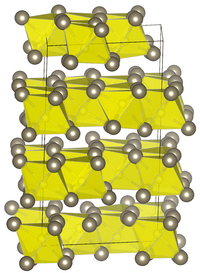Thallium(I) sulfide facts for kids
Quick facts for kids Thallium(I) sulfide |
|
|---|---|
 |
|
| IUPAC name | Thallium(I) sulfide |
| Other names | thallous sulfide, thallous sulphide |
| Identifiers | |
| CAS number | |
| PubChem | |
| EC number | 215-250-8 |
| SMILES | S([Tl])[Tl] |
| Properties | |
| Molecular formula | |
| Molar mass | 0 g mol-1 |
| Appearance | black crystalline solid |
| Density | 8.390 g/cm3 |
| Melting point | |
| Boiling point | |
| −88.8·10−6 cm3/mol | |
| Structure | |
| Crystal structure | Trigonal, hR81 |
| Space group | R3, No. 146 |
| Except where noted otherwise, data are given for materials in their standard state (at 25 °C, 100 kPa) | |
Thallium(I) sulfide, also known as thallous sulfide, is a chemical compound. Its chemical formula is Tl2S. It has thallium and sulfide ions in it. The thallium is in its +1 oxidation state.
Properties
Thallium(I) sulfide is a black solid. It reacts with acids to make hydrogen sulfide and a thallium salt.
Occurrence and preparation
It is found as a mineral called carlinite, but it is rare. It is the only thallium sulfide mineral that does not have another metal in it. It is made in the laboratory by reacting thallium(I) sulfate with hydrogen sulfide or by heating thallium and sulfur together.
Uses
It was used in some of the first infrared detectors. One of the first reliable infrared detectors used thallium sulfide and it was made in World War II.
Related pages

All content from Kiddle encyclopedia articles (including the article images and facts) can be freely used under Attribution-ShareAlike license, unless stated otherwise. Cite this article:
Thallium(I) sulfide Facts for Kids. Kiddle Encyclopedia.
